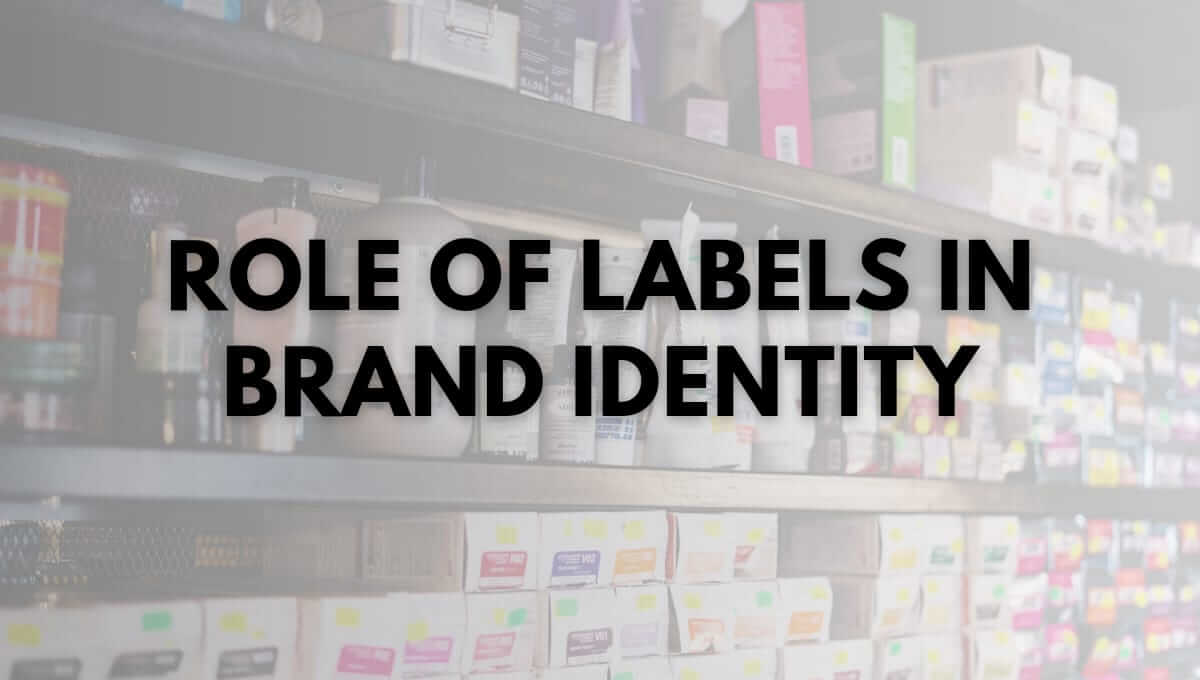Role of Labels in Brand Identity

Do you want to attract more customers? Stand out from the crowd and win the hearts of your target audience.
Then, you need to focus on building an unshakable brand identity.
One critical element of brand identity is the product label. Customizing labels for your target audience can put you two steps ahead of competitors.
When customers see your business logo or name on the product, they will immediately recognize your brand. Use this opportunity to build a connection with consumers and improve market positioning.
This guide will explore labels and how they shape brand identity. We will also share some of the most effective tips to use this strategy in your favor.
So let's get started.
How Labels Impact Brand Identity
Effective labeling can improve brand recognition. It conveys the brand message to customers if designed according to labeling principles. Let's understand it better with an example.
The product label is just like a book cover. Readers judge books by their covers, right?
If the cover is poorly designed, your book will sit on the bookshelf. That's why every designer puts extra time and effort into designing a book cover. Likewise, your product label serves as a book cover.
It should educate customers and make them say yes to your product. It plays a pivotal role in upscaling your brand identity and building customer trust.

1. Gain Attention Of Potential Customers
According to the latest stats, 50,000 new products are launched in the market every year. However, around 70% of these products fail to sustain the market.
Do you know why that happens? Why does the product remain unnoticed?
Mainly because of failure to connect with their customers. You should reconsider your product labeling options.
Shoppers are hesitant to try products from new brands. Let's understand this better with an example.
Imagine you're going to the supermarket to purchase a frozen food item. There are two brands on the shelf: A and B. You've been using brand A for the past ten years. Will you try brand B?
Most probably, no.
But if the features, designs, and benefits mentioned on the product label are compelling, you might consider trying brand B. So, add this information to the product label.
Often, shoppers try new brands on their second or third visit to the supermarket.
The retail shelf is cluttered with a wide range of products. You need to make the product stand out through thoughtful design.
2. Offer Essential Detailed Information
The label needs to provide customers with clarity about the product. The ideal way to do this is to look at your competitors. Analyze all the components they have added to the product label and how you can improve it.
It gives customers confidence in your product. Here are some additional tips to level up your product labels and enhance brand recognition.

- Add How To Use instructions on the product labels to educate customers about product usage instructions.
- Mention the manufacturing and expiration date of your product.
- Showcase your commitment to sustainability to attract eco-conscious customers.
- If you have a food product, check all the information, such as nutrients, allergen warnings, etc.
- Pharmaceutical companies include child safety warnings and dosage instructions.
- Be up-to-date about the latest labeling market trends, rules, and regulations.
3. Speak Directly To Your Customer Base
The most common mistake businesses make is failing to connect with the customers directly. As a result, customers purchase the product from competitors. Even if you're only printing visuals on the labels, it should speak to the customers.
But how?
The best example of this is beverages and juice brands. Fruit juice brands often show appetizing images on the label, which evokes emotions in customers. You should be clear about the vision behind the product you're selling to customers.
Use labels to communicate your brand message to customers. With creative product labeling, businesses can unlock their potential.
Is your brand focused on Gen-Z friendly? Does your business revolve around eco-friendly initiatives?
Your labels should speak about these approaches through labels. Don't write long paragraphs or essays on your product labels. The attention span of people is reducing, so lengthy messages won't help your business. Use images and content to convey the message.
Visually appealing images + Persuasive copy = Increases product sales
4. Level Up Your Packaging
Don't ignore your packaging if you want to improve your brand recognition. Your packaging and label should resonate with each other, and that's how customers will easily recognize your brand.
But what if you ignore it?
Then, you won't be able to fulfill the consumer preferences and needs. If the packaging is not good, then you won't be able to put a label on it. But don't worry—here are some solutions to fix this problem.
- Use premium quality containers or packaging material for your product.
- Use unique packaging approaches like adding textures or scents to the packaging and label.
- Be clear about the label size and how much you want to show off the product.
5. Keep Pricing In Mind
Making great labels doesn't mean breaking the bank. You can indeed create eye-catching labels without reckless spending.
The cost of the label generally depends on the labeling agency you're partnering with. Connect with a reputable agency with experience in leveling up labels. Choosing the wrong agency is equivalent to wasting time, money, and business potential.
While making labels, get clarity on your target audience and their design preferences. It's an investment in improving your brand identity.
Pro Tip: Ensure that your product label complies with legal regulations. Offer positive experiences to customers to build deeper connections. Maintain all safety standards and add essential branding elements to maximize marketing efforts.
Types Of Brand Labels
There are different types of unique brand labels. Each label has its unique purpose and impact on brand identity. Labels are vital for building a strong presence and staying in minds of consumers.
Here's an overview of some common brand labels to get consumer attention.
|
Types Of Brand Labels |
||
|
Label Type |
Description |
Impact On Brand Identity |
|
Adhesive Labels |
Stick directly onto the product or packaging, typically paper or vinyl. |
Great for consistency across products Enhances brand recognition with uniformity |
|
Shrink Sleeves |
A full 360-degree label that wraps around the product. |
Offers bold, standout designs Great for showcasing the brand from all angles |
|
In-Mold Labels |
Embedded in the product packaging during manufacturing. |
Conveys a sense of durability and quality Suitable for brands focused on longevity and reliability |
|
Pressure-Sensitive Labels |
Similar to stickers, applied with pressure without heat or water. |
Useful for creating detailed, high-quality designs Improves product presentation |
|
Wraparound Labels |
Applied by wrapping around the product, typically cylindrical items. |
Provides a complete, immersive brand experience for consumers Ideal for industries with high competition |
|
Sustainable Labels |
Made from eco-friendly, recyclable, or biodegradable label materials. |
Reinforces environmental and ethical brand identity Appeals to modern, eco-conscious consumers |
|
Hang Tags |
Tags attached with a string are often used outside of the packaging. |
Adds a premium, tactile experience to the brand Ideal for storytelling |
Survey To Improve Labels For Brand Identity

If you have a product, you must analyze whether it resonates with your customers. But is it really important?
Yes.
Because that's how you can compel them to purchase the product, you should gather customer feedback and incorporate it into improving the product label. Conduct a survey and ask your customers these questions.
- Are they purchasing your product for the first time?
- Are they satisfied with the packaging?
- Is the quality of the product label up to the mark?
- Was the product visible on the retail shelf, or did they search for it?
- Did they get all the necessary information about the product?
By asking these questions, you can understand customers. Here's how it happens.
Unique product labels → Excites customers → Improved brand recognition → Purchases products → Increases in sales
Your aim should be to impact customer purchasing decisions. Use customized informative labeling to complement the product and enhance its awareness.
Strategies for Effective Label Design
By now, you know the importance of brand labels in elevating brand identity. But to make them 10x more effective, here are some strategies you should implement.
- Color Scheme: Use unique brand colors that reflect your brand identity.
- Typography: Avoid using fonts that are too large or too small and hard to read.
- Imagery: Incorporate engaging visuals that connect with your target audience.
To Sum Up
High-quality labels are not just pieces of information. They are like product identifiers that can build consumer trust in the business. So, how can you forge long-term customer relationships?
To attract customers to your business, you need to invest in premium materials, prioritize consistent branding elements, and implement custom solutions.
At Altro Labels, we assist businesses in attracting customers' attention through unique and customized labels. So, if you're ready to take your business to the next level, reach out to us today. Check our stellar portfolio here.
Want to know more about different aspects of product labeling?
Then check out our detailed premium guides here. These guides include valuable insights to help you grow your business through labels and packaging.
